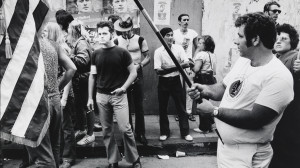Things began to change with the Stonewall Riots in New York City. Gay men and lesbians were beginning to emerge from the shadows.
“It was a political revolution, it was a social revolution, it was a cultural revolution,” Kilhefner says. “It was a spiritual revolution in consciousness for gay people.”
It’s what Friedkin wanted to capture with his camera. Friedkin grew up around gay people — his father was a Hollywood writer and director, his mother a dancer at Paramount Studios.
But while capturing images of an emerging community long in the shadows made perfect sense to him, he was a little ahead of his time.
“Some of my best friends were like, ‘Why are you photographing gay people?’” Friedkin recalls. “‘Like what’s up with you? Are you gay? You know, why are you doing this, ya know?’”
But Friedkin wasn’t deterred. Between 1969 and 1973, he spent months hanging out first in Los Angeles, then in San Francisco. On the streets, in bars and nightclubs — sometimes in club bathrooms as drag queens transformed into character. These are some of Friedkin’s favorite photographs.
“And these are big men who weigh, two, three hundred pounds,” Friedkin says. “They’re like football players. They have lipstick on and beautiful brassieres and necklaces around their neck. And also visually it was exciting to photograph them because just how they put it all together. It was like that Kinks’ song ‘Lola.’”
After hearing about the San Francisco drag troupe The Cockettes, Friedkin went to San Francisco, photographing the performers – including Divine – in a North Beach theater.
“I wanted to photograph gays who were willing to take the chance and be courageous and go out the door and say, ‘This is who I am and I’m proud of it,’” Friedkin says.
Although he titled this collection of black and white photos The Gay Essay, he wasn’t making it for a gay audience. He wanted to share his work — documenting a movement and using the images to convey the empathy he felt for his subjects. But his work got only minor attention. Until now.
The de Young Museum in San Francisco is featuring The Gay Essay now through January 11, 2015. The de Young’s photography curator Julian Cox says Friedkin’s collection never got the attention it deserved.
“Friedkin’s own efforts to get the photography into the best museums in the country that were working with photography at the time was [sic] not successful,” Cox says. “And it’s taken him 40 years to make it happen.”
The reason, Cox says, is that there was a limited audience, and limited opportunities to reach them.
“The expression of gay lifestyles is so common in our culture nowadays, from television to videomaking and music as well that it’s not really an issue anymore,” Cox says. “At the time Friedkin was making The Gay Essay it was still red hot.”
And too hot to touch, at least for most galleries of the day. In fact, homosexuality was still illegal in California. The FBI and the LAPD infiltrated gay political and social groups. There was entrapment, harassment and police brutality.
Through it all, Friedkin kept working with his Leica M4 camera. The result: a sensuous collection that also documents an era. There are drag queens and hustlers, intimate images of gay and lesbian couples, teenagers just discovering their sexuality. Friedkin’s photos capture the humanity of them all.
“There was this incredible need for intimacy and physical passion with each other,” Friedkin says. “The desire to connect, to communicate, to love one another. And I saw it more and more in the photographs.”
Art critic Hal Fisher worked for Artweek in the 1970s. He says to fully appreciate The Gay Essay you have to appreciate how Friedkin used the rapport he developed.
“Anthony Friedkin’s work goes beyond documentation,” Fisher says. “It’s art. It’s not just people saying, ‘Oh, I’m going to the gay day parade I’m going to photograph it.’”
As San Francisco holds its annual Gay Pride parade this weekend, Kilhefner hopes Friedkin’s photos help younger LGBT generations understand how a rag-tag group of hippies, hustlers, drag queens and activists laid the foundation for this extraordinary era of civil rights progress.
“It’s going to allow gay people to look back and say, ‘Oh my God, that’s what they looked like then. That’s what they were wearing then. That’s what they were doing,'” Kilhefner says. “These are the people who lived that formative period of our history called the beginning of gay liberation.”




